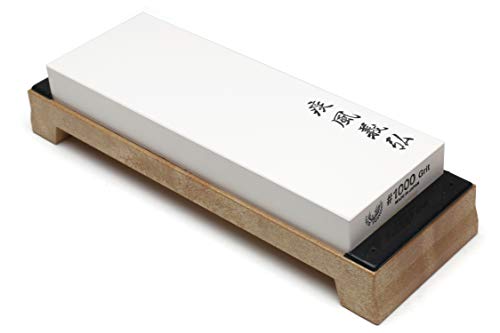
A Japanese knife is a precision tool, known for its sharpness and exquisite craftsmanship. The traditional method of sharpening a Japanese knife involves the use of a whetstone, which requires patience and skill. However, there is a common misconception that a Japanese knife cannot be sharpened with a steel, also known as a honing rod.
Contrary to popular belief, a Japanese knife can indeed be sharpened with a steel, but it is important to understand the difference between honing and sharpening. Honing is the process of realigning the edge of the knife, while sharpening is the process of removing material to create a new edge. A steel is typically used for honing, while a whetstone is used for sharpening.
Using a steel to hone a Japanese knife can help maintain its sharpness between sharpenings. The process involves sliding the knife blade against the steel at a specific angle, which helps to align any minor deformations and keep the edge aligned. It is important to note that using a steel does not actually sharpen the knife, but rather helps to keep it in optimal condition.
Sharpening Japanese Knives
Japanese knives are known for their exceptional sharpness and precision, making them a popular choice among professional chefs and cooking enthusiasts. However, like any other knife, Japanese knives require regular sharpening to maintain their edge and prolong their lifespan.
When it comes to sharpening Japanese knives, it’s important to note that the traditional method involves the use of whetstones. Whetstones, also known as water stones, are abrasive stones that are specifically designed for sharpening knives.
The first step in sharpening a Japanese knife is to soak the whetstone in water for about 10-15 minutes. This will ensure that the stone is properly saturated and ready for use. Once the whetstone is ready, you can start sharpening your knife.
Hold the knife at a 15-20 degree angle to the whetstone and apply light pressure as you move the knife back and forth across the stone. Make sure to maintain a consistent angle throughout the sharpening process to achieve an even edge. Start with a coarser grit whetstone and gradually move to a finer grit for a more polished edge.
It’s important to keep the knife and the whetstone wet during sharpening to prevent heat buildup and ensure effective sharpening. You can periodically splash water on the whetstone or use a spray bottle to keep it moist.
After sharpening, rinse the knife with water to remove any metal shavings and wipe it dry with a cloth. You can test the sharpness of the knife by slicing through a piece of paper or a tomato. If the knife slices through effortlessly, it’s properly sharpened.
Remember to take your time and be patient when sharpening Japanese knives. It may take some practice to achieve the desired sharpness, but with consistent practice, you’ll be able to maintain the exceptional sharpness of your Japanese knives for years to come.
Using a Steel for Sharpening
When it comes to sharpening a Japanese knife, many people wonder if they can use a steel for this task. The answer is both yes and no.
A steel, also known as a honing rod or sharpening rod, is a long, cylindrical tool made of steel or ceramic. It is commonly used to realign the edge of a knife and keep it sharp between sharpening sessions. However, using a steel alone is not sufficient for sharpening a dull blade.
When a knife becomes dull, its edge loses its sharpness due to wear and tear. Simply honing the edge with a steel will not remove the worn metal and restore the blade’s sharpness. It will only help to realign the edge and temporarily improve the cutting performance.
To truly sharpen a Japanese knife, a different method is required. This typically involves using a sharpening stone or a whetstone. These abrasive stones are designed to remove material from the blade and shape a new, sharp edge. They come in different grits, each serving a specific purpose in the sharpening process.
When using a sharpening stone, it is important to follow proper techniques and maintain a consistent angle to achieve a precise and sharp edge. This process may require some skill and practice, but it is worth the effort to maintain the performance and longevity of a Japanese knife.
Once the blade is properly sharpened, you can use a steel to regularly maintain its sharpness. After each use, a few quick swipes on a steel can help to realign the edge and keep the knife performing at its best.
In conclusion, while a steel can be a useful tool for maintaining the sharpness of a Japanese knife, it is not sufficient for sharpening a dull blade. For sharpening purposes, a sharpening stone or whetstone should be used to remove material and shape a new edge.
Pros and Cons of Using a Steel
Using a steel, also known as honing, is a common practice in maintaining the sharpness of Japanese knives. However, like any sharpening method, there are both pros and cons to consider before using a steel.
Pros
1. Easy to Use: Using a steel is a relatively simple process that can be done quickly and easily. It provides a convenient way to touch up the edge of a knife between more intensive sharpening sessions.
2. Cost Effective: Compared to other sharpening methods, using a steel is a cost-effective option. Stones and other sharpening tools can be expensive, but a steel can be a more affordable choice for regular maintenance.
3. Maintains Knife Sharpness: Regularly using a steel can help maintain the sharpness of a Japanese knife. It removes any small burrs or inconsistencies in the edge, allowing the knife to perform at its best.
Cons
1. Does Not Replace Sharpening: While using a steel can help maintain the sharpness of a knife, it does not replace the need for periodic sharpening. Over time, using a steel alone may not be enough to restore a dull blade to its optimal cutting performance.
2. Limited Effectiveness for Damaged Blades: If a knife is significantly damaged or has a dull edge, using a steel alone may not be enough to restore its sharpness. In such cases, more intensive sharpening methods may be necessary.
3. Requires Skill and Technique: Using a steel effectively requires some skill and technique. It is important to maintain the correct angle and pressure while honing the knife to avoid damaging the blade or creating an uneven edge.
| Pros | Cons |
|---|---|
| Easy to use | Does not replace sharpening |
| Cost effective | Limited effectiveness for damaged blades |
| Maintains knife sharpness | Requires skill and technique |
Alternative Sharpening Methods
If you don’t have access to a traditional whetstone or prefer not to use it, there are alternative methods to sharpen your Japanese knife. These methods may not give you the same level of precision as using a whetstone, but they can still be effective in maintaining the sharpness of your blade.
1. Honing Rod
A honing rod, also known as a sharpening steel or a butcher’s steel, is a rod-shaped tool made of steel or ceramic. While it is commonly used to realign the edges of a knife, it can also be used to sharpen the blade.
To use a honing rod, hold the knife at a 20-degree angle against the rod and swipe the blade across the rod, starting from the base of the blade to the tip. Repeat this process several times on both sides of the blade until you achieve the desired sharpness.
Note: Make sure to check the manufacturer’s guidelines for the proper use of a honing rod, as different materials and designs may require specific techniques.
2. Pull-Through Sharpeners
Pull-through sharpeners are compact sharpening tools that consist of two slots with built-in abrasive material. These tools are designed for easy and quick sharpening.
To use a pull-through sharpener, insert the blade into the appropriate slot and pull the knife through the slot, ensuring that the blade stays in contact with the abrasive material. Repeat this process several times to sharpen the knife. Be cautious not to apply too much pressure, as it may damage the blade.
Note: Pull-through sharpeners may not be suitable for all types of Japanese knives, especially those with harder steel. It is important to choose a pull-through sharpener that is compatible with your knife.
3. Guided Sharpening Systems
Guided sharpening systems are tools designed to help you maintain a consistent angle while sharpening your knife. These systems typically consist of a base, a sharpening stone, and a guide that holds the knife at the desired angle.
To use a guided sharpening system, secure the knife in the guide and move it back and forth across the sharpening stone, following the manufacturer’s instructions. These systems can be helpful for beginners or those who struggle with maintaining a consistent angle.
Note: Guided sharpening systems may vary in design and complexity. It is important to read the instructions carefully and ensure that you are using the system correctly to avoid any damage to your knife.
Tips for Sharpening Japanese Knives
Japanese knives are known for their sharpness and precision, but they require regular maintenance to keep them in optimal condition. Sharpening a Japanese knife can be a delicate process, but with the right techniques and tools, you can achieve a razor-sharp edge. Here are some tips to help you sharpen your Japanese knives:
1. Choose the Right Sharpening Stone
When sharpening a Japanese knife, it’s important to use a high-quality sharpening stone specifically designed for this purpose. Japanese water stones, such as the whetstone or the ceramic stone, are ideal for maintaining the sharpness of your knife. These stones are available in different grits, so choose one that suits the current condition of your knife.
2. Soak the Sharpening Stone
Before using a water stone, it’s important to soak it in water for the recommended amount of time. This will ensure that the stone is properly saturated and will provide optimal sharpening results. Follow the manufacturer’s instructions for soaking time, as it may vary depending on the type of stone you are using.
3. Hold the Knife Properly
When sharpening a Japanese knife, it’s essential to hold the knife at the correct angle. Most Japanese knives have a beveled edge, so you’ll need to maintain a consistent angle during the sharpening process. A sharpening guide or a honing guide can help you achieve the correct angle and keep it consistent.
4. Use Light Pressure
When using a sharpening stone, it’s important to apply light pressure to the knife blade. Excessive pressure can cause the blade to become overheated, resulting in damage to the knife. Allow the stone to do the work and focus on maintaining the correct angle rather than applying too much force.
5. Sharpen Both Sides of the Blade
To achieve a balanced and sharp edge, it’s important to sharpen both sides of the knife blade. Alternate between each side, making sure to maintain the same number of strokes on each side. This will help you achieve an even and symmetrical edge.
6. Hone the Knife
After sharpening your Japanese knife, it’s important to hone it to remove any burrs and smooth out the edge. A leather strop or a fine-grit honing rod can be used for this purpose. Lightly draw the knife across the honing surface to refine the edge and ensure it’s razor-sharp.
By following these tips, you can keep your Japanese knives in excellent condition and maintain their unparalleled sharpness. Regular sharpening will not only enhance the performance of your knives but also extend their lifespan.






